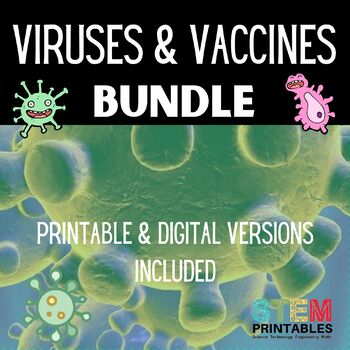Viruses & Vaccines Bundle (Covid-19) Printable & Digital | Distance Learning
- Zip
- Easel Activity
Products in this Bundle (5)
Bonus
Description
Updated! This bundle includes everything you need to teach your students about viruses (including Covid-19) and the process of making vaccines.
**Updated 3/14/21 - This bundle contains products that have been updated to reflect the most current CDC Guidance and information regarding new Covid-19 virus mutations, and current vaccine effectiveness against new strains.
Distance Learning: This activity can be assigned to students via Google Classroom or other digital learning platform, a PDF file can be emailed to student, or a hard copy can be printed and given to students.
Topics covered in this bundle
- What is a virus?
- Parts of a typical virus: capsid, RNA/DNA, receptors
- Structure of covid-19 Virus
- How is covid-19 transmitted?
- Prevention of covid-19 infection and treatment
- How big is a virus?
- Types of Viruses: rhinoviruses, coronaviruses, influenza, RSV, HIPVs, adenoviruses,
- Diseases caused by viruses: cold, flu, covid-19, bronchitis, pneumonia, MERS,SARS
- 3 Components of Modern Cell Theory
- Bacteriophages
- Structure of a Bacteriophage: capsid, collar, sheath, base plate, tail fiber
- Lytic Virus Life Cycle
- Lysogenic Virus Life Cycle
- Immune Systems Response to Infection: leukocytes, Helper T Cells
- Symptoms and Treatment for Virus Infections
- What is the difference between Epidemic and Pandemic?
- How are vaccines made? (traditional & Platform Vaccine Technologies
- Vaccine Rapid Response Platforms
- Moderna Nucleic Acid Vaccine Platform
- Antigen
- Pathogen
- Recombinant Protein
- Messenger RNA
- Growth Medium
- Bioreactors
- Fermenters
- Viral Vaccines
- Antibiotics
- Chromatography
- Ultrafiltration
- Stabilizers
- Preservatives
- Adjuvant
- Freeze-dried Vaccines
- Rehydration of Vaccines
- Genetic Sequencing of Viral DNA
- Vaccine Rapid Response Platforms
- Epidemiology Case Study Simulation - students take on the role of a Public Health Director and work with a virtual expert epidemiologist to identify the cause of a respiratory virus outbreak and recommend a course of action to prevent an epidemic.
Tips for Customers
- Click the Green ★ to follow our store and get notifications of freebies and new products!
- Leave feedback to receive TpT credit for use on future purchases.
- Questions? Please contact us in the Product Q&A Section.
Terms of Use
All rights reserved by STEM Printables
This product is intended for use by the original purchaser only.
Sharing this product with others, distributing via any means, or posting online is strictly prohibited.
Failure to comply is a copyright infringement and a violation of the Digital Millennium Copyright Act (DMCA). Clipart and elements found in this PDF are copyrighted and cannot be extracted and used outside of this file without permission or license.


